Developing a Model to Assess the Potential Impact of TUM Hydropower Turbines on Small River Ecology
Abstract
:1. Introduction
2. Technical Aspects of the Shaft Power Plant and Study Area
3. Methodology
3.1. Hydrodynamic Model
3.2. Sedimentation Model
3.3. Habitat and Population Models
4. Numerical Methodology and Validation
5. Results
5.1. Velocity, Water Depth, and River Bed Deformation
5.2. Habitat Suitability Index Distribution
5.3. Fish Species Population Fluctuation
5.4. The Effects of the TUM Plant Construction
6. Discussion
6.1. Model System Advantage and Limitation
6.2. TUM Plant Hydro Concept Analysis
7. Conclusions
Author Contributions
Funding
Acknowledgments
Conflicts of Interest
References
- Yuksek, O.; Komurcu, M.I.; Yuksel, I.; Kaygusuz, K. The role of hydropower in meeting Turkey’s electric energy demand. Energy Policy 2006, 34, 3093–3103. [Google Scholar] [CrossRef]
- Gürbüz, A. The role of hydropower in sustainable development. History 2006, 20, 25-000. [Google Scholar]
- Twidell, J.; Weir, T. Renewable Energy Resources; Routledge: London, UK, 2015. [Google Scholar]
- Zarfl, C.; Lumsdon, A.E.; Berlekamp, J.; Tydecks, L.; Tockner, K. A global boom in hydropower dam construction. Aquat. Sci. 2015, 77, 161–170. [Google Scholar] [CrossRef]
- Penche, C. Guide on How to Develop a Small Hydropower Plant; European Small Hydropower Association (ESHA): Brussels, Belgium, 2014; 296p. [Google Scholar]
- Huang, S.; Chen, C.; Bai, Q.; Zheng, C. China hydropower current situation and future trends. Technol. Innov. Appl. 2016, 27, 204. [Google Scholar]
- Huang, H.; Yan, Z. Present situation and future prospect of hydropower in China. Renew. Sustain. Energy Rev. 2009, 13, 1652–1656. [Google Scholar] [CrossRef]
- Bhat, I.K.; Prakash, R. LCA of renewable energy for electricity generation systems—A review. Renew. Sustain. Energy Rev. 2009, 13, 1067–1073. [Google Scholar]
- Nguyen, T.H.; Everaert, G.; Boets, P.; Forio, M.A.; Bennetsen, E.; Volk, M.; Hoang, T.H.; Goethals, P.L. Modelling Tools to Analyze and Assess the Ecological Impact of Hydropower Dams. Water 2018, 10, 259. [Google Scholar] [CrossRef]
- Taele, B.M.; Mokhutšoane, L.; Hapazari, I. An overview of small hydropower development in Lesotho: Challenges and prospects. Renew. Energy 2012, 44, 448–452. [Google Scholar] [CrossRef]
- Okot, D.K. Review of small hydropower technology. Renew. Sustain. Energy Rev. 2013, 26, 515–520. [Google Scholar] [CrossRef]
- Höffken, J.I. A closer look at small hydropower projects in India: Social acceptability of two storage-based projects in Karnataka. Renew. Sustain. Energy Rev. 2014, 34, 155–166. [Google Scholar] [CrossRef]
- Cheng, C.; Liu, B.; Chau, K.W.; Li, G.; Liao, S. China’s small hydropower and its dispatching management. Renew. Sustain. Energy Rev. 2015, 42, 43–55. [Google Scholar] [CrossRef]
- Zhou, S.; Zhang, X.; Liu, J. The trend of small hydropower development in China. Renew. Energy 2009, 34, 1078–1083. [Google Scholar] [CrossRef]
- Paish, O. Small hydro power: Technology and current status. Renew. Sustain. Energy Rev. 2002, 6, 537–556. [Google Scholar] [CrossRef]
- Yi, M. There is great potential for small hydropower development in the world. China Water Electr. 2012, 9, 69. (In Chinese) [Google Scholar]
- Shang, S.; Gu, Z.; Cao, X. A review of hydropowerplant projects’ eco-hydraulic effects. Adv. Sci. Technol. Water Resour. 2014, 34, 14–19. [Google Scholar]
- Idsø, J. Small Scale Hydroelectric Power Plants in Norway. Some Microeconomic and Environmental Considerations. Sustainability 2017, 9, 1117. [Google Scholar] [CrossRef]
- Zhong, X.H. Degradation of ecosystem and ways of its rehabilitation and ways of its rehabilitation and reconstruction in dry and hot valley—Take representative area of Junsha river. Yunan Province as an example. Resour. Environ. Yangtza Basin 2000, 9, 376–383. [Google Scholar]
- Jackson, S.D. Ecological considerations in the design of river and stream crossings. In Proceedings of the International Conference on Ecology and Transportation, New York, NY, USA, 24–29 August 2003. [Google Scholar]
- Kibler, K.M.; Tullos, D.D. Cumulative biophysical impact of small and large hydropower development in Nu River, China. Water Resour. Res. 2013, 49, 3104–3118. [Google Scholar] [CrossRef]
- Parasiewicz, P. MesoHABSIM: A concept for application of instream flow models in river restoration planning. Fisheries 2001, 26, 6–13. [Google Scholar] [CrossRef]
- Huang, G.; Chen, Q.; Jin, F. Implementing eco-friendly reservoir operation by using genetic algorithm with dynamic mutation operator. In Life System Modeling and Intelligent Computing; Springer: Berlin/Heidelberg, Germany, 2010; pp. 509–516. [Google Scholar]
- Yao, W.; Rutschmann, P.; Bamal, S. Modeling of River Velocity, Temperature, Bed Deformation and its Effects on Rainbow Trout (Oncorhynchus mykiss) Habitat in Lees Ferry, Colorado River. Int. J. Environ. Res. 2014, 8, 887–896. [Google Scholar]
- Zhang, W.; Yao, W.; Li, L.; Zhang, Q. Using an Eco-hydrodynamic Model to Simulate the Impact of Trunk Dam Construction on Kraal River Fish Habitat and Community. Int. J. Environ. Res. 2016, 10, 227–236. [Google Scholar]
- U.S. Fish and Wildlife Service (USFWS). Habitat as a Basis for Environmental Assessment; USFWS, Report 101 ESM; USFWS: Fort Collins, CO, USA, 1980.
- Bovee, K.D. A Guide to Stream Habitat Analysis Using the Instream Flow Incremental Methodology; U.S. Fish and Wildlife Service: Washington, DC, USA, 1982.
- Bovee, K.D. Development and Evaluation of Habitat Suitability Criteria for Use in the Instream Flow Incremental Methodology; National Ecology Center, Division of Wildlife and Contaminant Research, Fish and Wildlife Service, US Department of the Interior: Washington, DC, USA, 1986; Volume 86.
- Ginot, V. EVHA, a Windows Software for Fish Habitat Assessment in Streams; Bulletin Francais de la Peche et de la Pisciculture: Lyon, France, 1995. [Google Scholar]
- Alfredsen, K.; Killingtveit, A. The habitat modelling framework: A tool forcreating habitat analysis programs. In Proceedings of the Second International Symposium on Habitat Hydraulics, Québec City, QC, Canada, 5–8 June 1996; pp. 215–227. [Google Scholar]
- Jorde, K.; Bratrich, C. Ecological evaluation of Instream Flow Regulations based on temporal and spatial variability of bottom shear stress and hydraulic habitat quality. In Proceedings of the 2nd International Symposium on Habitat Hydraulics, Ecohydraulics 2000, Quebec City, QC, Canada, 11–14 June 1996. [Google Scholar]
- Parasiewicz, P. The MesoHABSIM model revisited. River Res. Appl. 2007, 23, 893–903. [Google Scholar] [CrossRef]
- Wang, F.; Lin, B. Modelling habitat suitability for fish in the fluvial and lacustrine regions of a new Eco-City. Ecol. Model. 2013, 267, 115–126. [Google Scholar] [CrossRef]
- Zhang, W.; Zhao, L.; Yao, W.; Li, L. Optimization the operation of hydraulic dam for ecological flow requirement of You-Shui River due to the construction of hydropower stations. Lake Reserv. Manag. 2016, 32, 1–12. [Google Scholar] [CrossRef]
- Yao, W.; Kumar, V.; Rutschmann, P. Simulating dam effects on river deformation and rainbow trout (Oncorhynchus mykiss) population number. In Proceedings of the 7th River Flow 2014, Lausanne, Switzerland, 3–5 September 2014; pp. 2477–2483. [Google Scholar]
- Yao, W.; Bamal, S.; Rutschmann, P. Simulating High-Flow Effects (HFE) on river deformation and rainbow trout (Oncorhynchus mykiss) habitat. In Proceedings of the 7th River Flow 2014, Lausanne, Switzerland, 3–5 September 2014; pp. 2471–2476. [Google Scholar]
- Deangelis, D.L.; Gross, L.J. Individual-Based approach is most appropriate for a given problem? In Individual-Based Models and Approaches in Ecology: Populations, Communities, and Ecosystems; Chapman and Hall: New York, NY, USA, 1992; pp. 67–87. [Google Scholar]
- Grimm, V. Ten years of individual-based modelling in ecology: What have we learned and what could we learn in the future? Ecol. Model. 1999, 115, 129–148. [Google Scholar] [CrossRef]
- Hall, A.J.; McConnell, B.J.; Rowles, T.K.; Aguilar, A.; Borrell, A.; Schwacke, L.; Wells, R.S. Individual-based model framework to assess population consequences of polychlorinated biphenyl exposure in bottlenose dolphins. Environ. Health Perspect. 2006, 114, 60–64. [Google Scholar] [CrossRef] [PubMed]
- Harvey, B.C.; Jackson, S.K.; Lamberson, R.H. InSTREAM: The Individu-Al-Based Stream Trout Research and Environmental Assessment Model; US Department of Agriculture, Forest Service, Pacific Southwest Research Station: Albany, NY, USA, 2009; Volume 218.
- Bartholow, J.M.; Laake, J.L.; Stalnaker, C.B.; Williamson, S. A salmonid population model with emphasis on habitat limitations. Rivers 1993, 4, 265–279. [Google Scholar]
- Bartholow, J.M. Sensitivity of a salmon population model to alternative for-mulations and initial conditions. Ecol. Model. 1996, 88, 215–226. [Google Scholar] [CrossRef]
- Yao, W.; Rutschmann, P.; Bamal, S. Three High Flow experiment releases from Glen Canyon Dam on Rainbow Trout and Flannelmouth Sucker habitat in Colorado River. Ecol. Eng. 2015, 75, 278–290. [Google Scholar] [CrossRef]
- Yao, W.; Bui, M.; Rutschmann, P. Development of the ecohydraulic model system for assessing habitat and population status in freshwater ecosystems. Ecohydrology 2018. [Google Scholar] [CrossRef]
- Yao, W.; Chen, Y. Assessing three fish species ecological status in Colorado River, Grand Canyon based on physical habitat and population models. Math. Biosci. 2018. [Google Scholar] [CrossRef] [PubMed]
- Yao, W.; Chen, Y.; He, X. Glen Canyon Dam Operation Effects on Rainbow Trout Habitat and Population Status. Pol. J. Environ. Stud. 2018, 27, 1–12. [Google Scholar] [CrossRef]
- Yao, W.; Zhao, T.; Chen, Y.; Yu, G.; Xiao, M. Assessing the river habitat suitability and effects of introduction of exotic fish species based on anecohydraulic model system. Ecol. Inform. 2018, 45, 59–69. [Google Scholar] [CrossRef]
- Rutschmann, I.P.; Sepp, D.I.F.A.; Barbier, D.I.J. Das Schachtkraftwerk–ein Wasserkraftkonzept in vollständiger Unterwasseranordnung. In Wasserkraftprojekte; Springer Fachmedien: Wiesbaden, Germany, 2013; pp. 286–291. [Google Scholar]
- Martins, D.E.C.; Seiffert, M.E.B.; Dziedzic, M. The importance of clean development mechanism for small hydro power plants. Renew. Energy 2013, 60, 643–647. [Google Scholar] [CrossRef]
- Acreman, M.C.; Ferguson, A.J.D. Environmental flows and the European water framework directive. Freshw. Biol. 2010, 55, 32–48. [Google Scholar] [CrossRef]
- Sepp, A.; Rutschmann, P. Ecological hydroelectric concept shaft power plant. In Proceedings of the International Seminar on Hydro Power Plants, Vienna, Austria, 6–9 November 2014. [Google Scholar]
- Rutschmann, P.; Schäfer, S. Das Schachtkraftwerk—Konzept, Funktion und Betrieb. Wasserkr. Ener. 2015, 21, 32–39. [Google Scholar]
- Lucchetti, E.; Barbier, J.; Araneo, R. Assessment of the technical usable potential of the TUM Shaft Hydro Power plant on the Aurino River, Italy. Renew. Energy 2013, 60, 648–654. [Google Scholar] [CrossRef]
- Rutschmann, P.; Sepp, A.; Geiger, F.; Barbier, J. TUM shaft hydro power-efficient and ecological. WasserWirtschaft 2011, 101, 33–36. [Google Scholar] [CrossRef]
- Rodi, W. Turbulence Models and Their Application in Hydraulics; CRC Press: Boca Raton, FL, USA, 1993. [Google Scholar]
- Parker, G.; Paola, C.; Leclair, S. Probabilistic Exner sediment continuity equation for mixtures with no active layer. J. Hydraul. Eng. 2000, 126, 818–826. [Google Scholar] [CrossRef]
- Van Rijn, L.C. Sediment transport, part III: Bed forms and alluvial roughness. J. Hydraul. Eng. 1984, 110, 1733–1754. [Google Scholar] [CrossRef]
- Van Rijn, L.C. Sediment transport part I: Bed load transport. J. Hydraul. Eng. ASCE 1984, 110, 1431–1456. [Google Scholar] [CrossRef]
- Van Rijn, L.C. Principles of Sediment Transport in Rivers, Estuaries and Coastal Seas; Aqua Publications: Amsterdam, The Netherlands, 1993; Volume 1006. [Google Scholar]
- Russ, G.R.; Alcala, A.C. Marine reserves: Long-term protection is required for full recovery of predatory fish populations. Oecologia 2004, 138, 622–627. [Google Scholar] [CrossRef] [PubMed]
- Shepherd, J.J.; Stojkov, L. The logistic population model with slowly varying carrying capacity. ANZIAM J. 2007, 47, C492–C506. [Google Scholar] [CrossRef]
- Bratrich, C.; Truffer, B.; Jorde, K.; Markard, J.; Meier, W.; Peter, A.; Wehrli, B. Green hydropower: A new assessment procedure for river management. River Res. Appl. 2004, 20, 865–882. [Google Scholar] [CrossRef]
- Vaughan, I.P.; Diamond, M.; Gurnell, A.M.; Hall, K.A.; Jenkins, A.; Milner, N.J.; Naylor, L.A.; Sear, D.A.; Woodward, G.; Ormerod, S.J. Integrating ecology with hydromorphology: A priority for river science and management. Aquat. Conserv. 2009, 19, 113. [Google Scholar] [CrossRef]
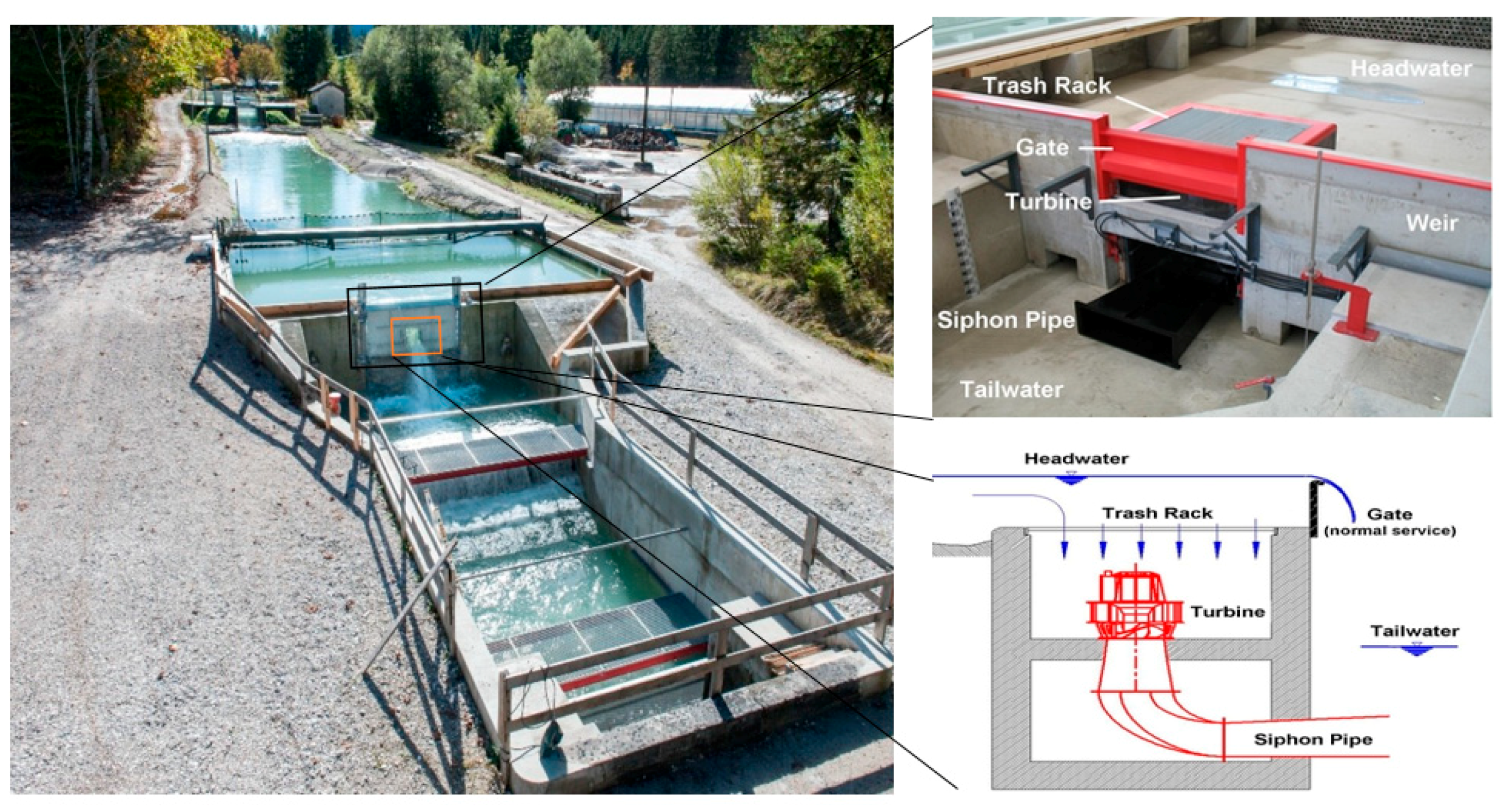
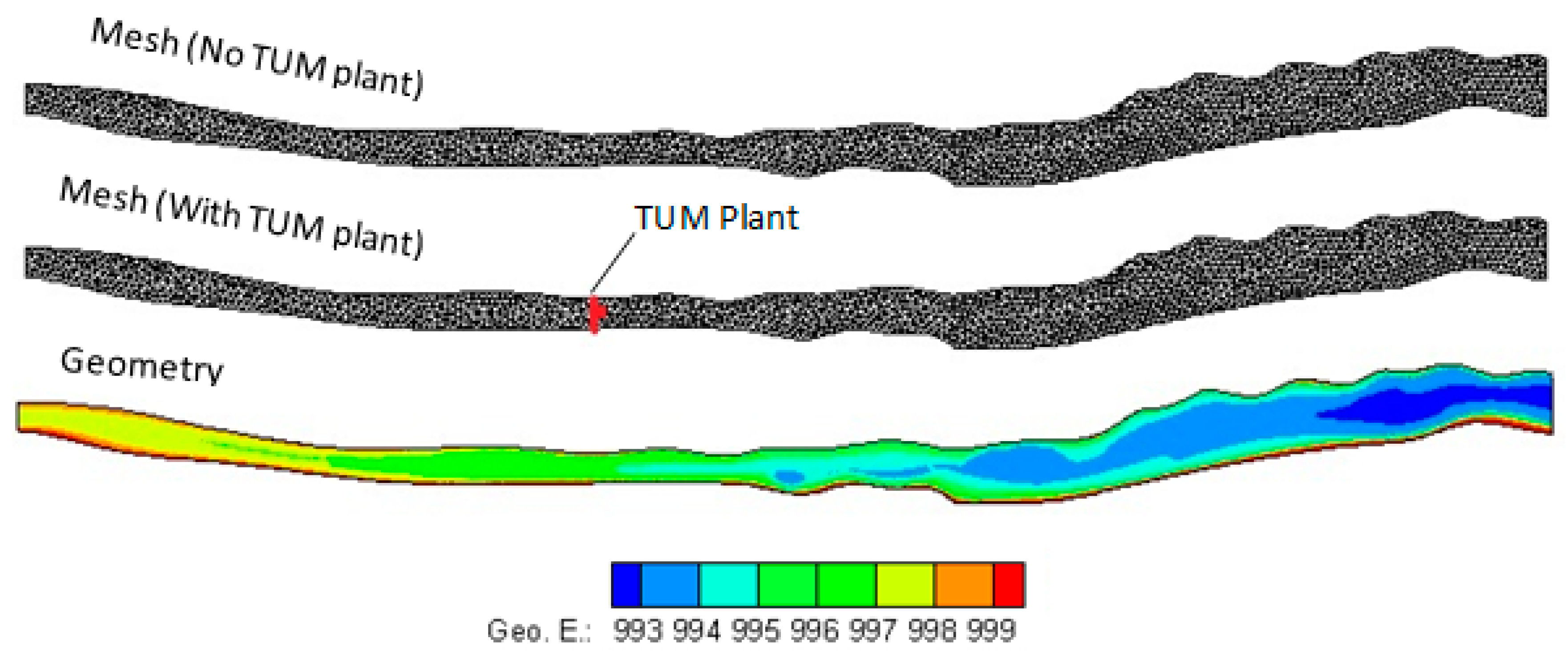
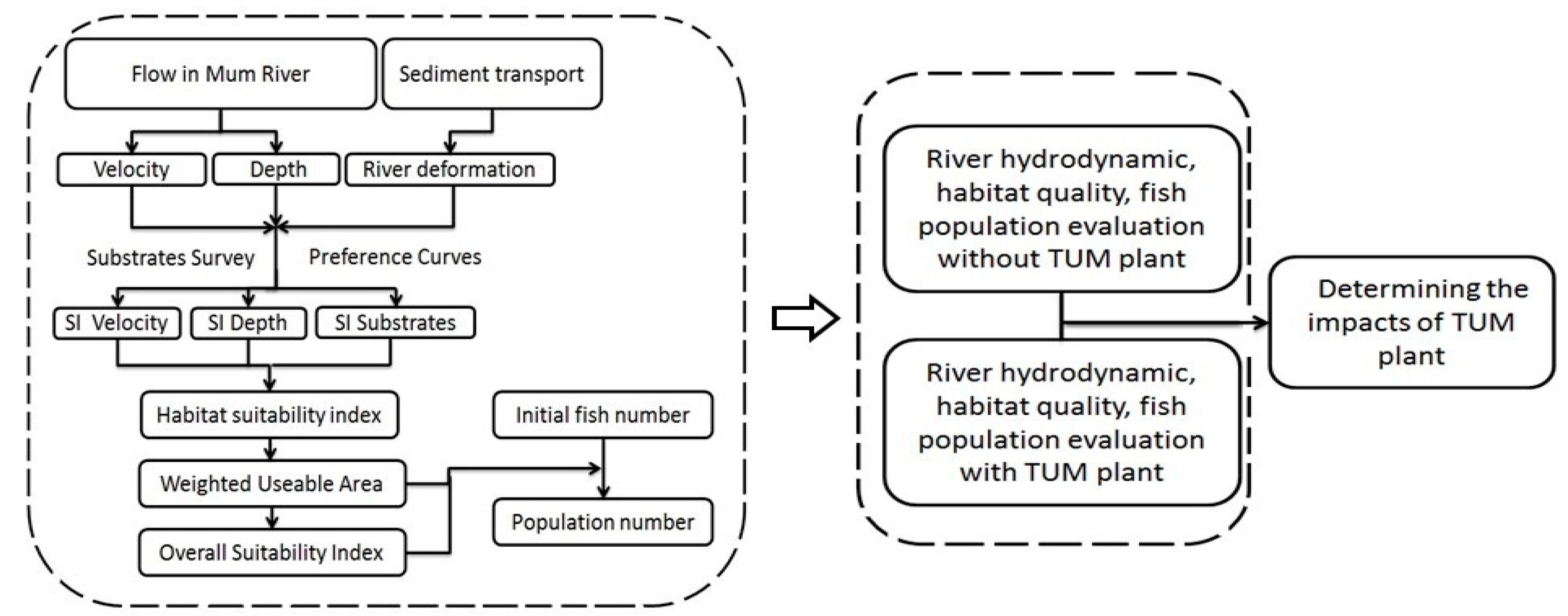
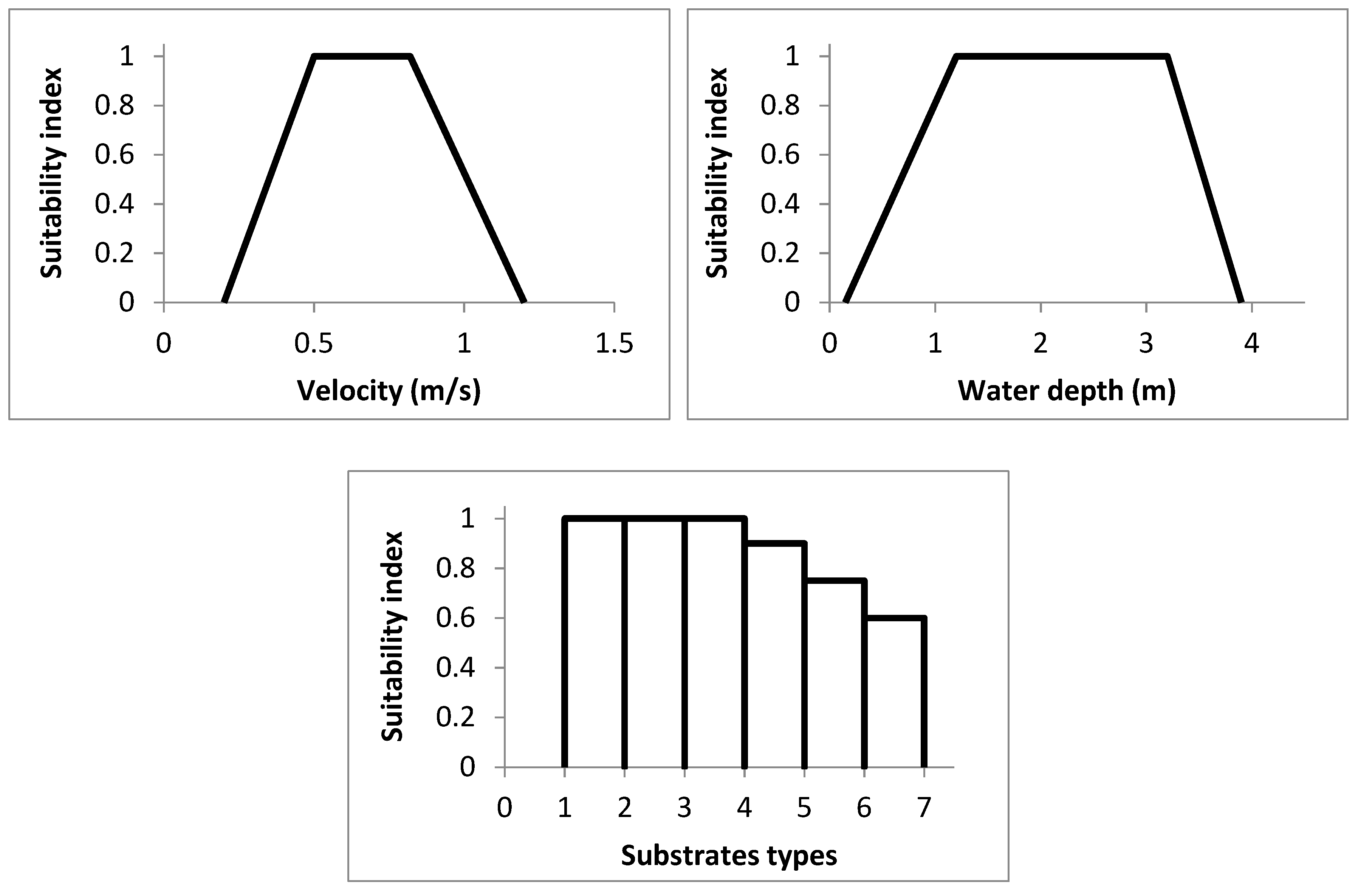
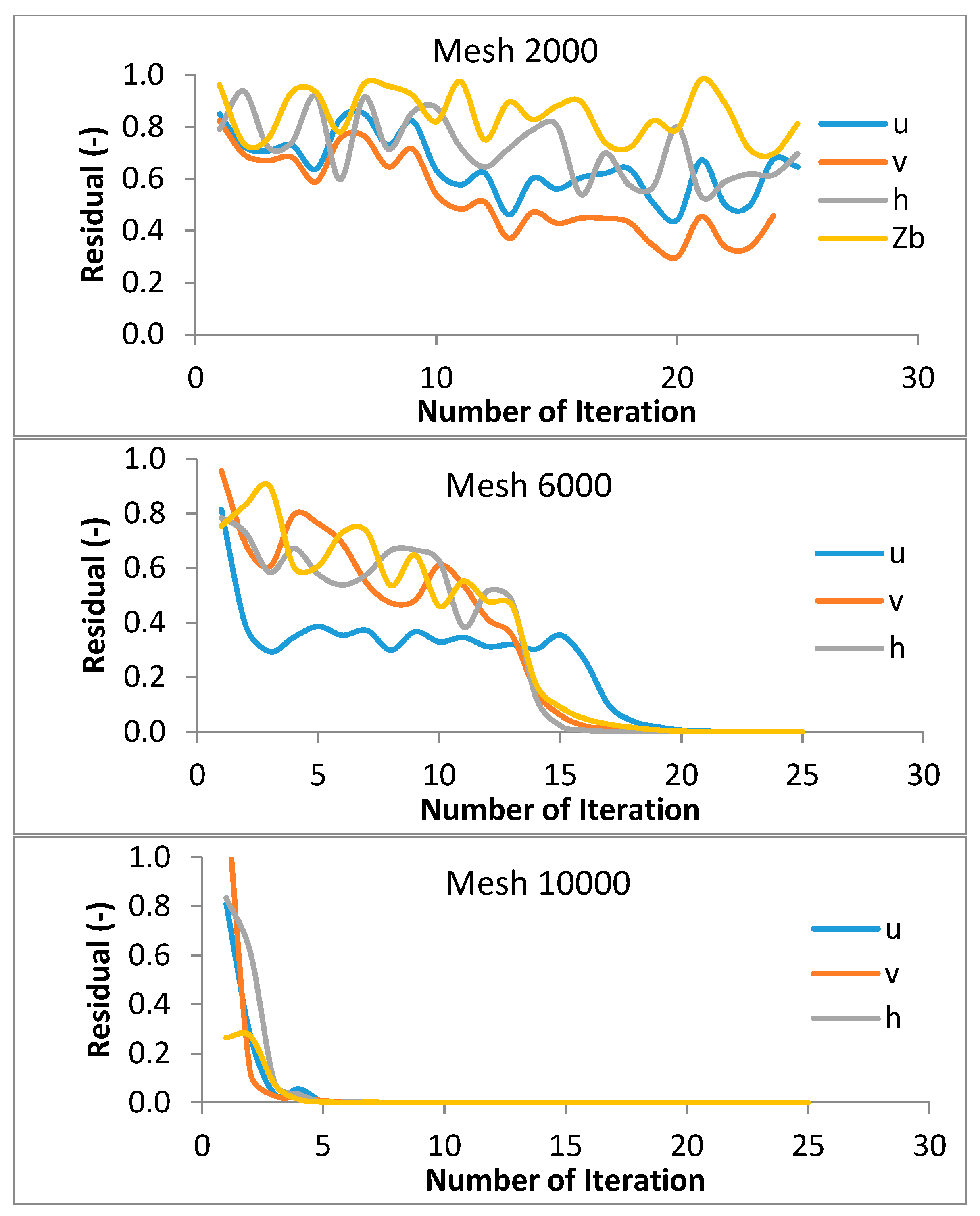
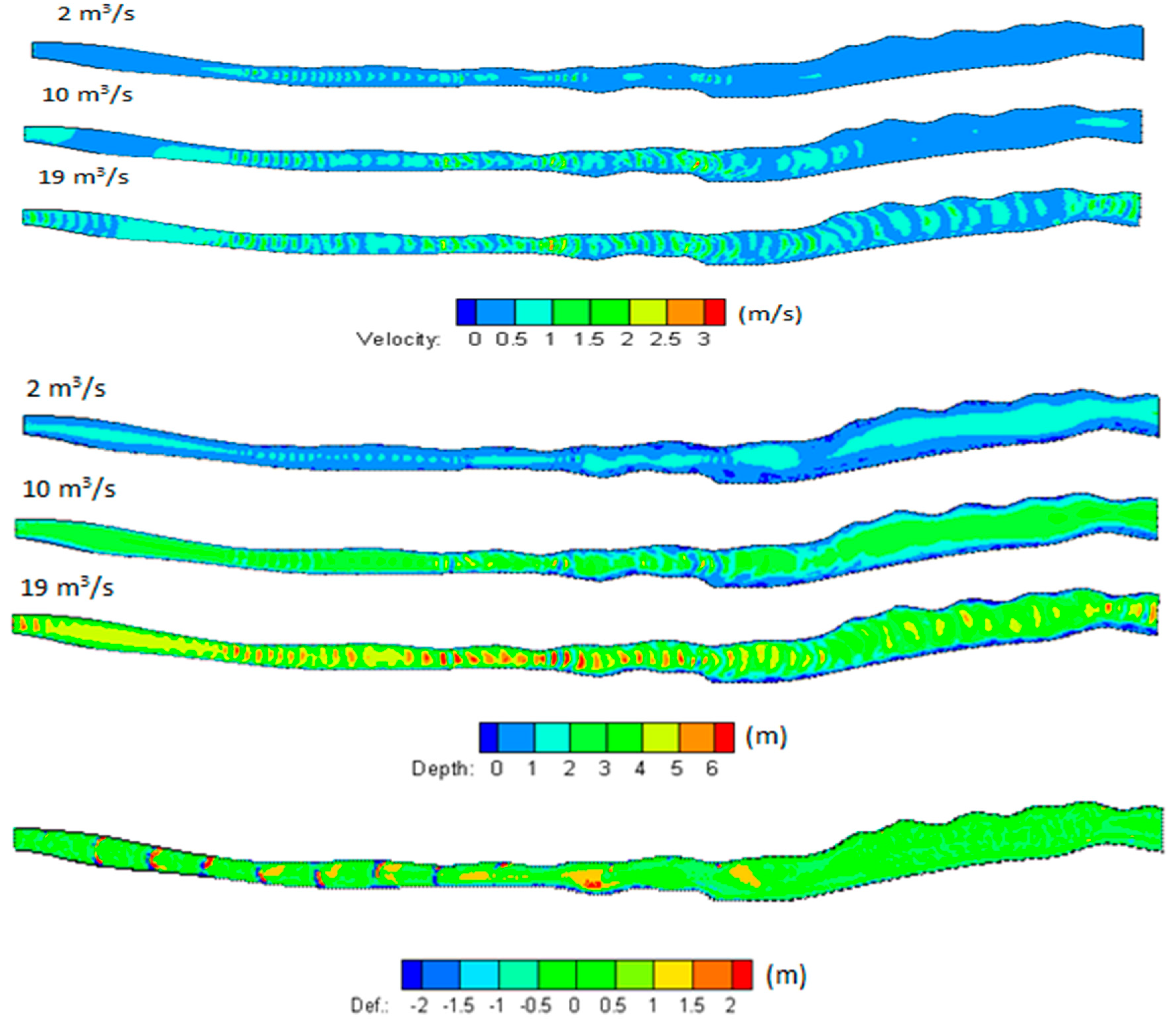
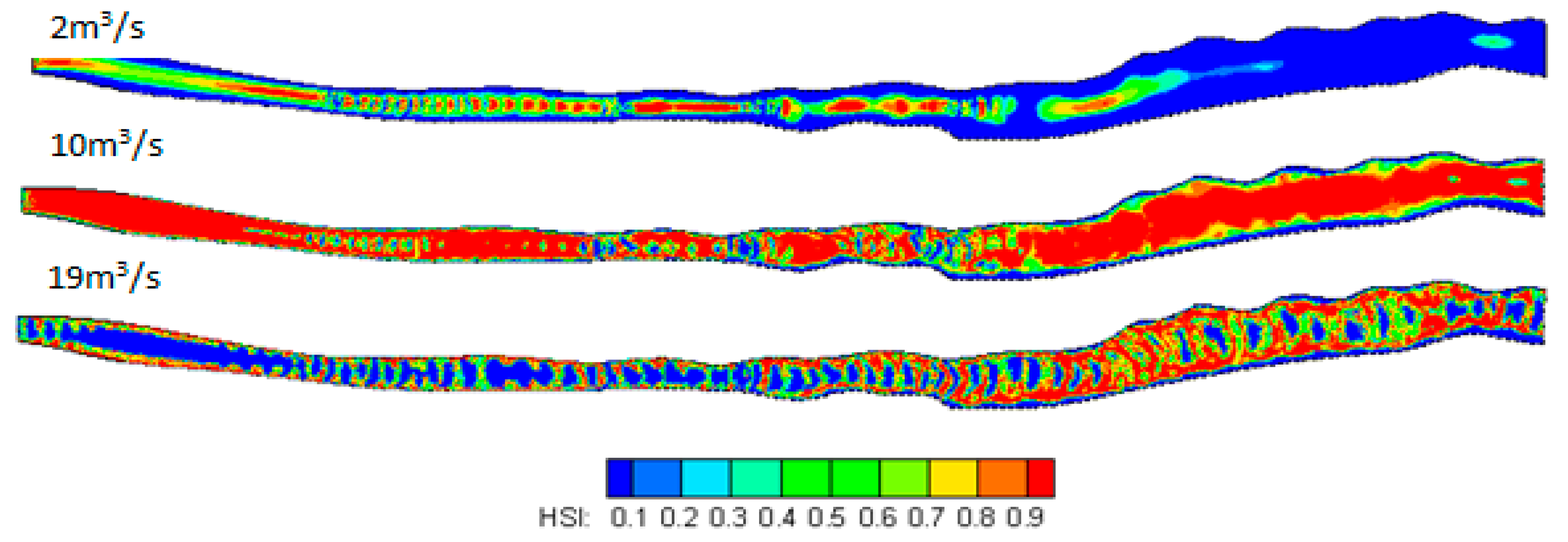

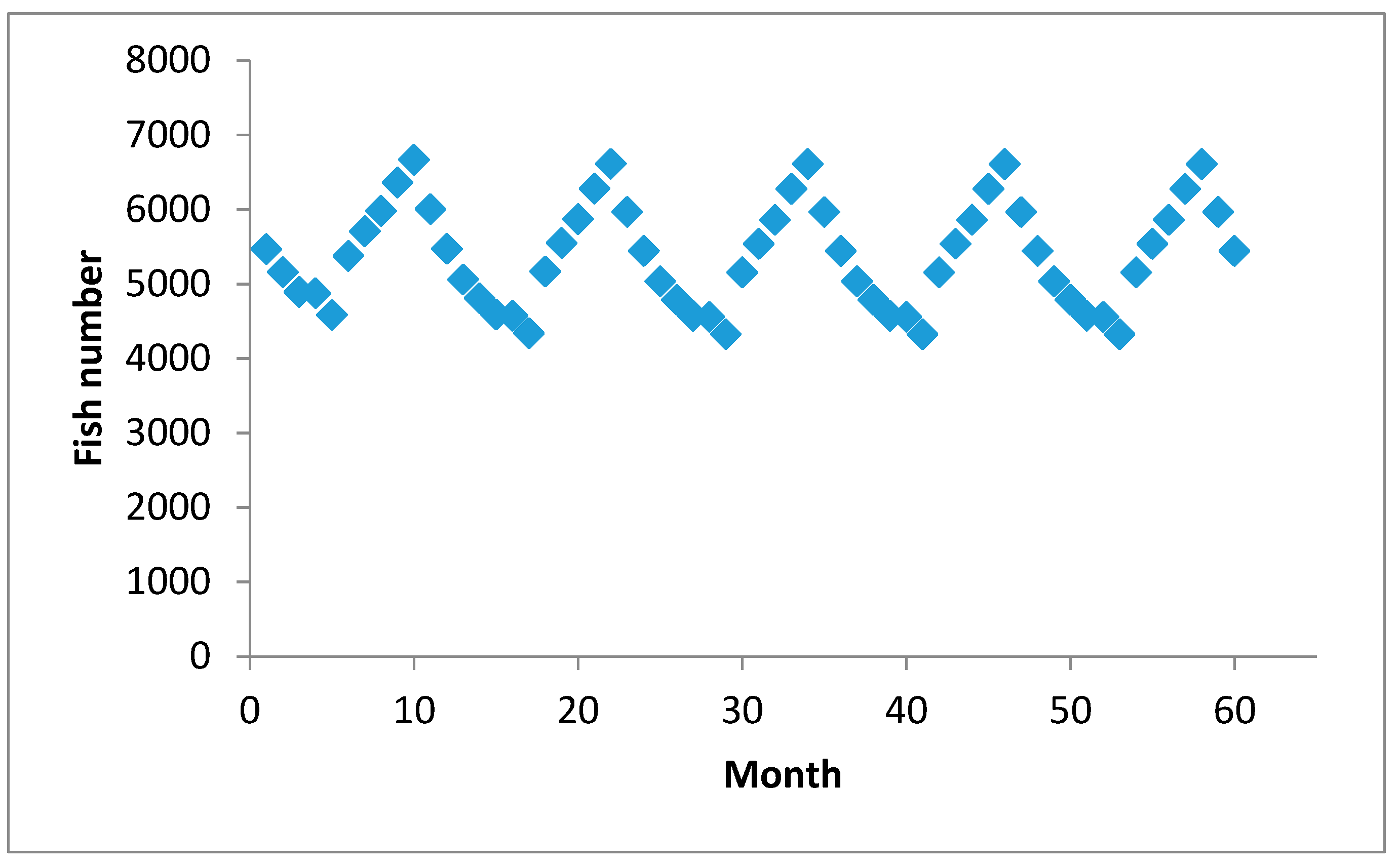
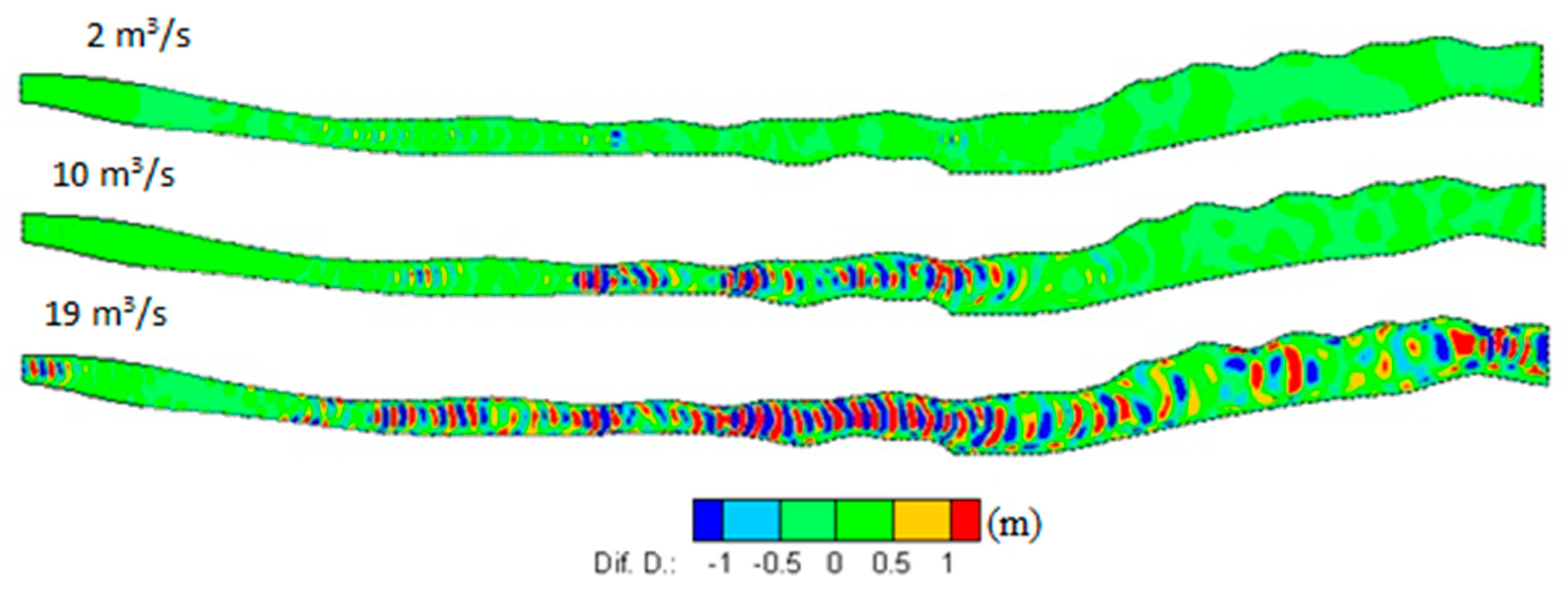
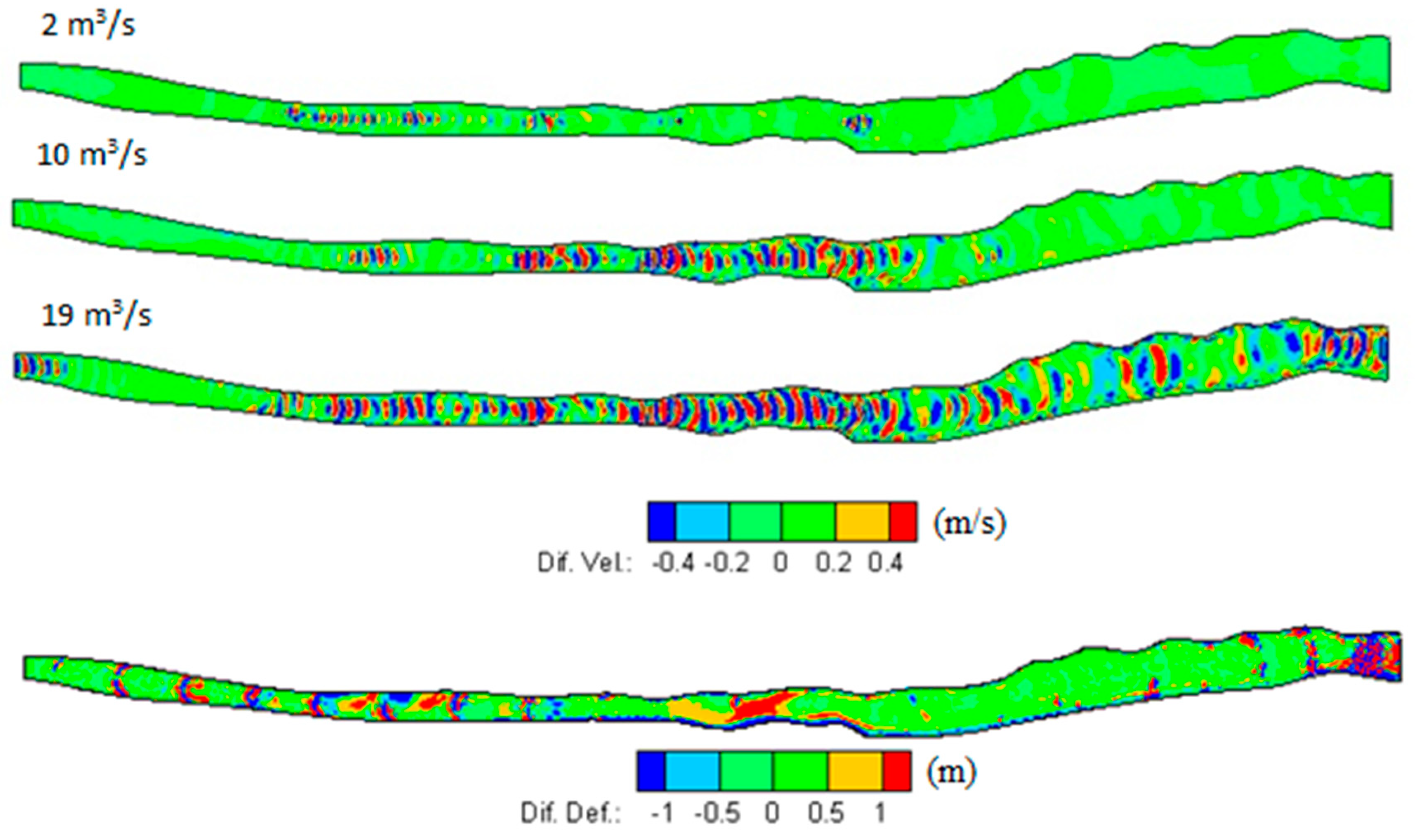
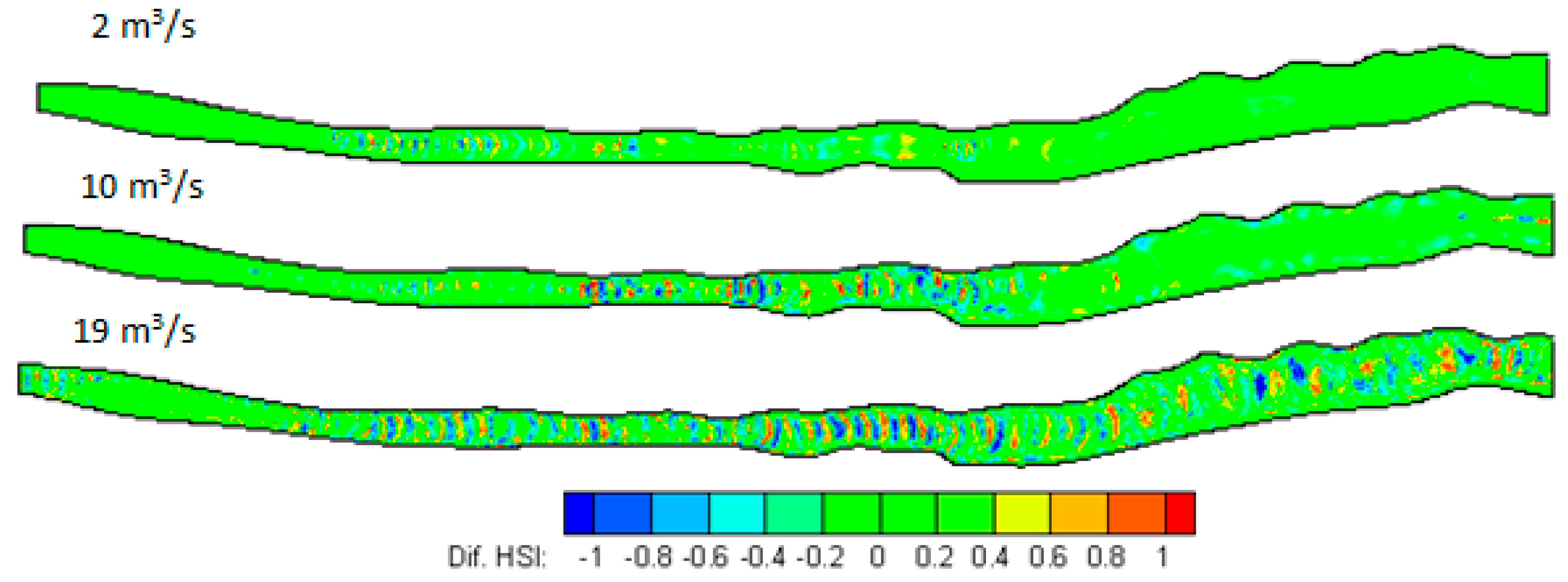
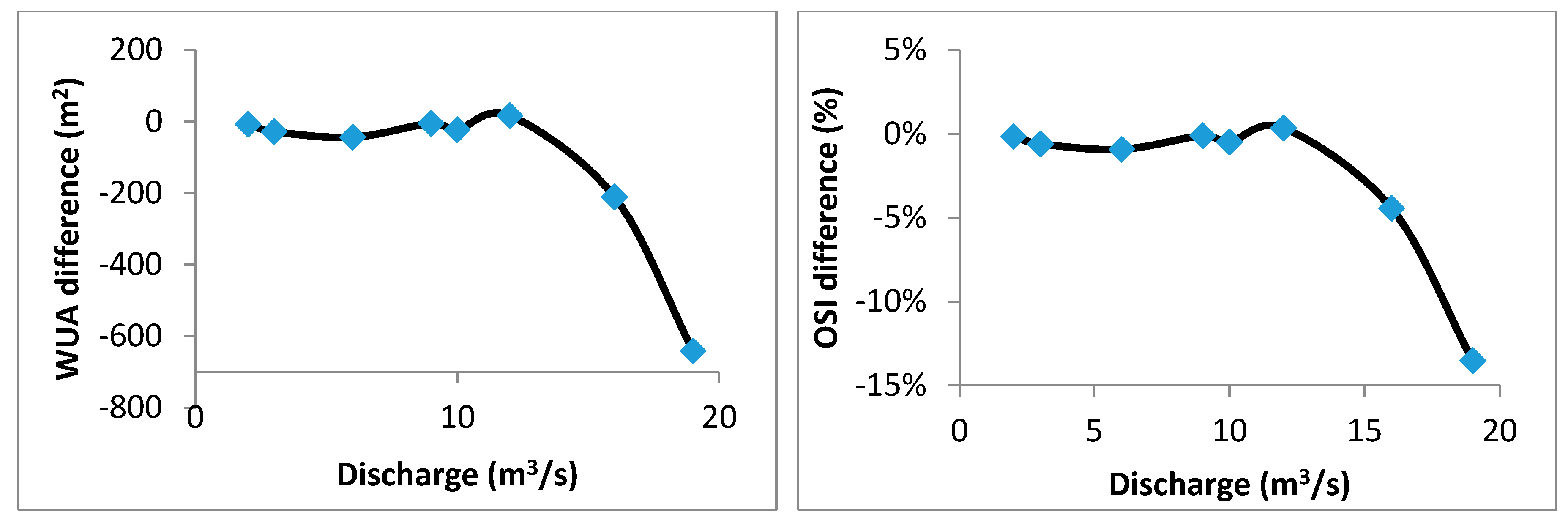
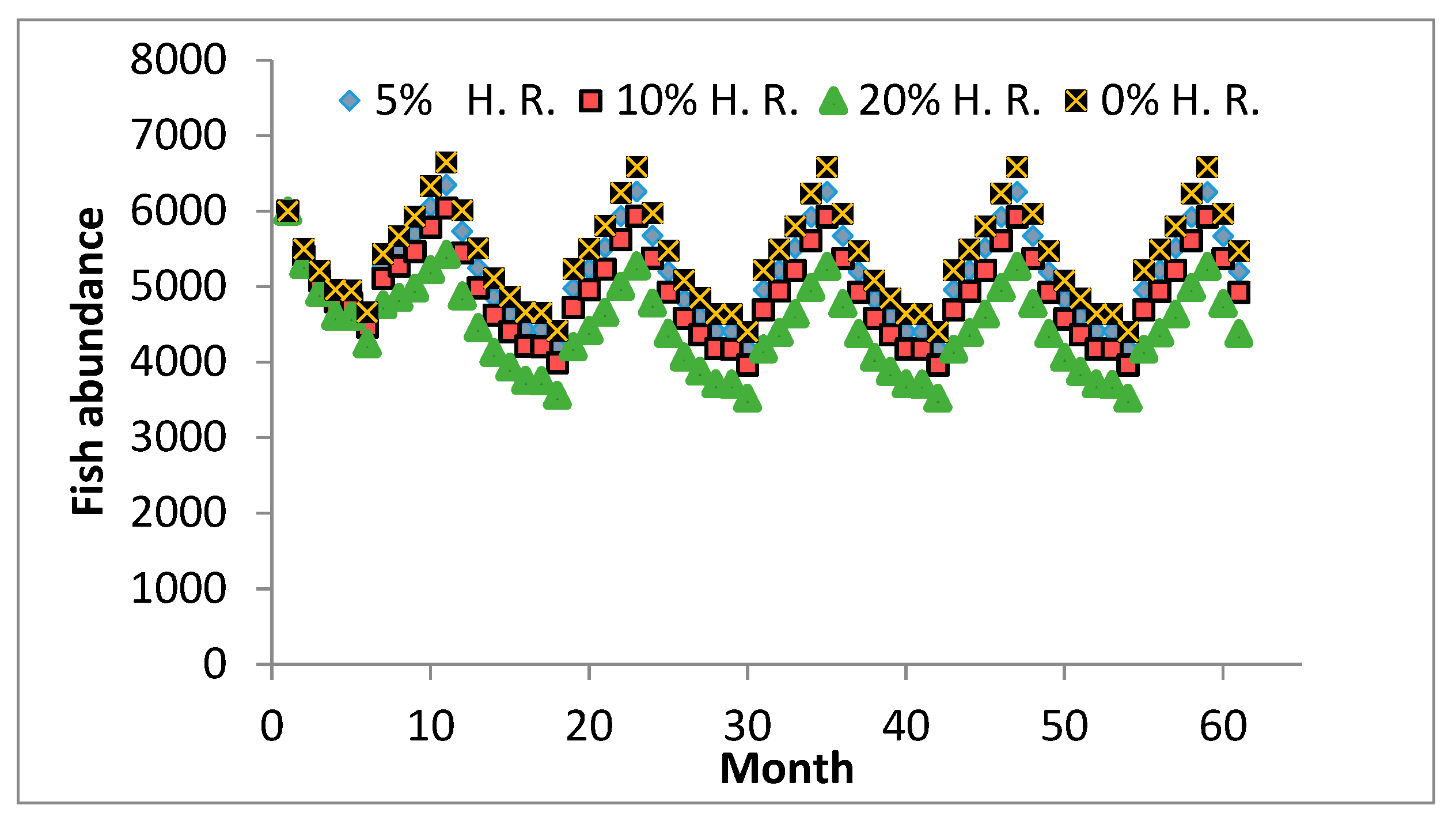
| Discharge (m3/s) | WUA (%) | OSI (%) |
|---|---|---|
| 2 | 0.8 | 0.8 |
| 3 | 2.15 | 2.15 |
| 6 | 2.13 | 2.13 |
| 9 | 1.44 | 1.44 |
| 10 | 0.64 | 0.64 |
| 12 | 0.5 | 0.5 |
| 16 | 6.7 | 6.7 |
| 19 | 20.86 | 20.86 |
© 2018 by the authors. Licensee MDPI, Basel, Switzerland. This article is an open access article distributed under the terms and conditions of the Creative Commons Attribution (CC BY) license (http://creativecommons.org/licenses/by/4.0/).
Share and Cite
Yao, W.; Chen, Y.; Yu, G.; Xiao, M.; Ma, X.; Lei, F. Developing a Model to Assess the Potential Impact of TUM Hydropower Turbines on Small River Ecology. Sustainability 2018, 10, 1662. https://doi.org/10.3390/su10051662
Yao W, Chen Y, Yu G, Xiao M, Ma X, Lei F. Developing a Model to Assess the Potential Impact of TUM Hydropower Turbines on Small River Ecology. Sustainability. 2018; 10(5):1662. https://doi.org/10.3390/su10051662
Chicago/Turabian StyleYao, Weiwei, Yuansheng Chen, Guoan Yu, Mingzhong Xiao, Xiaoyi Ma, and Fakai Lei. 2018. "Developing a Model to Assess the Potential Impact of TUM Hydropower Turbines on Small River Ecology" Sustainability 10, no. 5: 1662. https://doi.org/10.3390/su10051662
APA StyleYao, W., Chen, Y., Yu, G., Xiao, M., Ma, X., & Lei, F. (2018). Developing a Model to Assess the Potential Impact of TUM Hydropower Turbines on Small River Ecology. Sustainability, 10(5), 1662. https://doi.org/10.3390/su10051662






